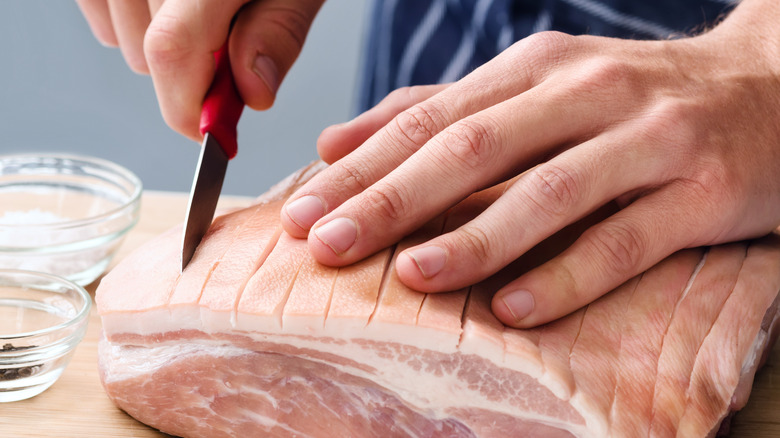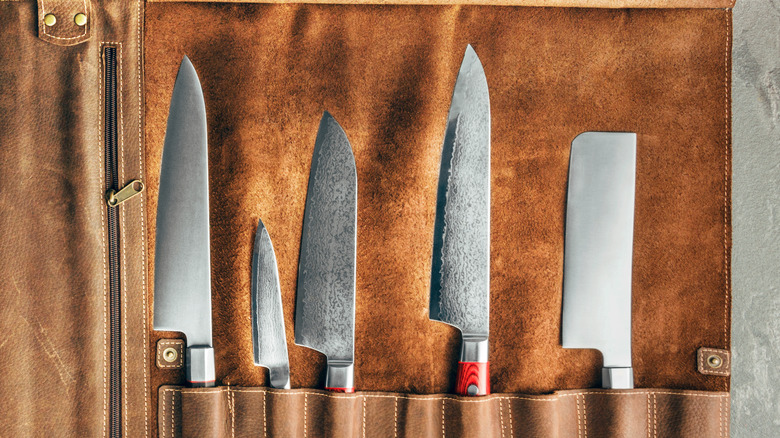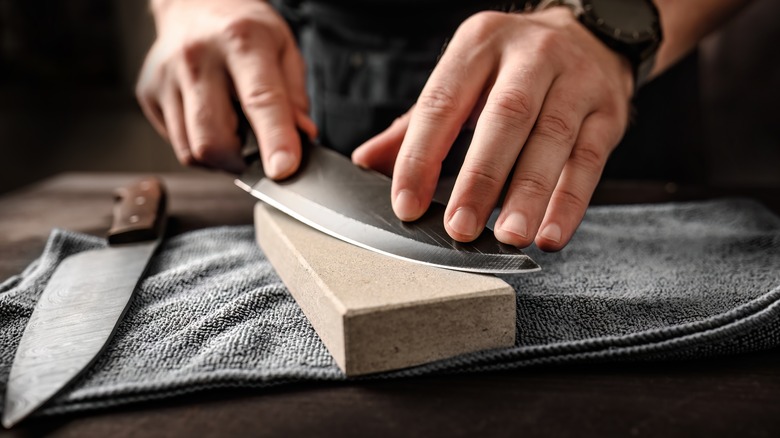Make Sure You Have The Right Type Of Knife For Scoring Meat
What's more satisfying than devouring a juicy piece of crackling? As your teeth sink in, the crispy skin gives way to an abundance of richly succulent and salty flavor. Scoring meat is essential to achieving a crisp, fatty rind that hits all the right spots, but it's also beneficial for intensifying the marinating process and keeping the meat in shape. For whatever reason you intend to score meat, it is paramount that a sharp knife is used.
Regardless of the cut of meat, a sharp, clean, and smooth knife is vital. Scoring means making thin, uniform slits across the surface of the meat. The process is one of care, and ensuring your knife is sharp is a part of the art. Sharp knives grip the surface of the meat, compared to dull blades, which are considered a hazard as they are more likely to slip.
You can score meat on both sides if needed. These scores should be parallel slits, measuring approximately ½ an inch deep at diagonals along the flesh. You can then turn the meat and repeat similarly spaced cuts to produce a cross-hatch pattern. Equal precision will create even crackling, uniform cooking, and the best marination. While you may have a variety of sharp knives at your disposal, an agile blade is essential.
Which knife should you use?
The "sharp knife" category could include a serrated, carving, tomato, or cheese knife, and even a cleaver. But all of these should be avoided for scoring. Larger knives are best for cutting larger pieces of meat but will not give you small, thin cuts. Serrated knives, like a tomato, cheese, or bread knife, are all designed with their named purpose in mind.
Due to the shallow cuts you wish to create, the optimal knife to use when scoring meat is a paring knife. A paring knife usually measures 2 to 4 inches, making it an agile and controllable blade. Traditionally used on ingredients that demand little pressure, like peeling potatoes or mincing garlic, paring knives can gracefully score fatty cuts of meat.
Various paring knives are on the market, from affordable options to those with dazzling hilts. While an engraved handle may look stylish, comfort is key. The more comfortable you feel with a knife, the more confidently you will score your cut of meat. A sharp point tip and lightweight feel are the most desirable characteristics, as these will provide accuracy and make maneuvering around the meat easier.
The art of sharpening a knife
Scoring meat requires a sharp blade, and each kitchen knife demands a different sharpening method. The delicate paring knife is best sharpened with a whetstone or water stone. These stones are made from various materials, although they usually fall into three categories: diamond, ceramics, or aluminum oxide. Their flat surface makes them perfect for paring knives because it enables the blade to be refined without compromising the knife's flexibility. In addition, sharpening a paring knife with a whetstone gives you greater precision than other tools.
These specialized stones usually come with a grit count that ranges from 1,000 to 8,000. The condition of your paring knife will determine which grit count you'll need — the higher the grit, the sharper the finish. All whetstones need to be soaked in water before being used, as this will prevent the knife from catching on the dry grit and creating more damage. For knives to remain sharp, a little care goes a long way — whether avoiding glass cutting boards or storing knives appropriately. Remember these tips next time you're preparing to score meat; you will find the process much more effortless and your meal all the more enjoyable.


